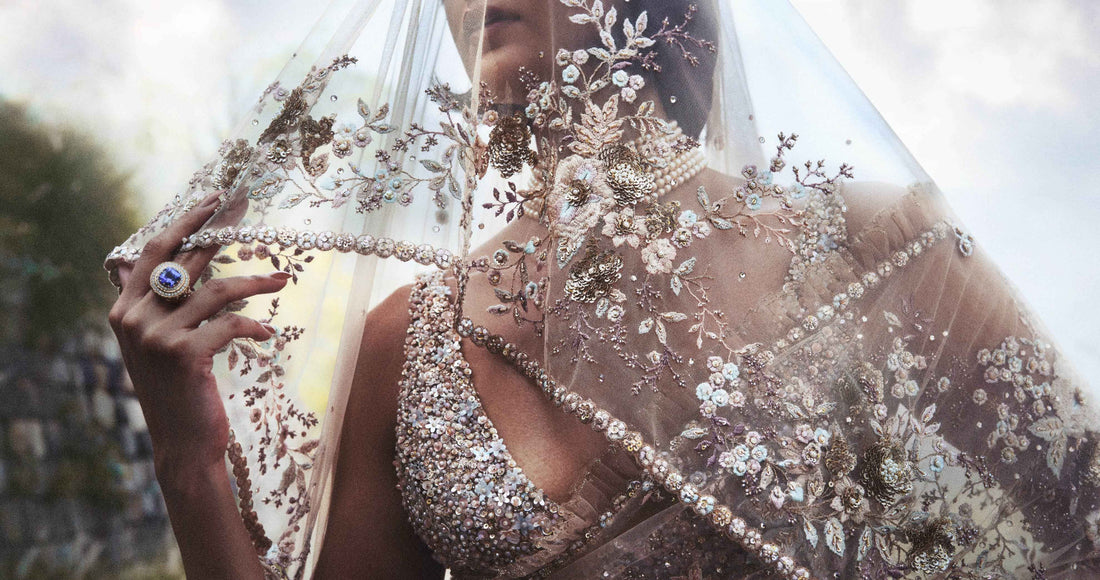
Scandinavian Shawl vs Dupatta
Share
Scandinavian Shawl vs Dupatta: The Ongoing Debate
In the modern world of fashion, cultural garments continue to be a powerful representation of identity and heritage. Two such garments, the Scandinavian shawl and the Indian Dupatta, have transcended their traditional roles to become symbols of femininity and elegance. While both items share common ground in their soft, luxurious fabrics and draped designs, the cultural narratives and modern-day influences surrounding each garment are what set them apart.
The debate between the Scandinavian shawl and the Dupatta isn’t just a question of style, but of meaning, heritage, and feminine identity. To fully understand the importance of these garments, we need to explore their origins, symbolic meaning, and the role they play in modern fashion.
The Origins of the Scandinavian Shawl
A Historical Overview
The Scandinavian shawl dates back centuries, finding its origins in the cold, harsh climates of Northern Europe. Historically, the shawl was not just a fashion accessory but a practical garment designed to keep women warm in the icy Scandinavian winters. These shawls were typically made from high-quality materials such as wool, cashmere, or even delicate silk, depending on the wearer’s social status.
Early on, shawls were crafted by hand, often passed down through generations as prized possessions. Over time, the shawl evolved into more than just a functional piece of clothing. In the 18th and 19th centuries, it became a symbol of refinement and luxury in Scandinavian high society.
The Evolution of the Scandinavian Shawl in Fashion
During the Victorian era, shawls became a prominent part of women’s fashion across Europe, including Scandinavia. These shawls were often adorned with intricate embroidery or woven patterns, symbolising not just wealth but artistic expression. As travel and trade flourished, the designs of Scandinavian shawls started to incorporate influences from other cultures, blending local traditions with international trends.
In the 20th century, the Scandinavian shawl became more versatile. No longer just a garment for the upper class, it started to be worn by women from all walks of life, thanks to its elegance and functionality. The shawl’s place in modern fashion has been cemented by its timeless appeal, making it a staple in women’s wardrobes around the world

Image: Antique Cream Purple Victorian Paisley Shawl, 1800s Woven Wool Paisley Wrap, 19th Century Textile
Paisley Shawl: Paisley shawls originated in Kashmir, India and rose in popularity within Europe in the mid 1800s due to the tastes of Queen Victoria.
The Dupatta: A Cultural Emblem
Historical Roots of the Dupatta
The Dupatta, also known as chunni or odhni, has a history that dates back thousands of years in the Indian subcontinent. Traditionally worn by women across India, Pakistan, and Bangladesh, the Dupatta is a long scarf-like garment draped over the shoulders, head, or body, symbolising modesty and grace.
Historically, the Dupatta was worn with garments such as the lehenga choli or salwar kameez, both of which are traditional Indian outfits. In many parts of India, the Dupatta was not just a symbol of modesty, but also of social status. The fabric, embroidery, and length of the Dupatta could indicate the wearer’s wealth and standing in society.
Dupatta Symbolism and Functionality in Indian Culture
The Dupatta plays a significant role in Indian culture and fashion, serving both practical and symbolic purposes. It’s a garment that embodies femininity, modesty, and elegance, often used in religious and ceremonial contexts. In Indian weddings, the Dupatta is often an integral part of the bride’s attire, symbolising blessings, beauty, and prosperity.
In everyday wear, the Dupatta is seen as an extension of the Indian woman’s personality—flowing, graceful, and powerful. It can be used to shield the face from the sun, add a layer of warmth in cooler weather, or simply enhance the beauty of an outfit. Over the years, the Dupatta has maintained its cultural relevance while also evolving with modern trends.

Image: Bridal Attire by Sabyasachi
Meaning of the Words: Shawl vs Dupatta
To better understand the debate between the Scandinavian shawl and the dupatta, we must look at the meaning of the words themselves.
Shawl: The word “shawl” comes from the Persian word “shal,” meaning a piece of cloth used for draping over the body. The term was introduced to Europe in the 17th century, where it became a popular accessory for women.
Dupatta: The word “dupatta” originates from the Sanskrit word “dupatta,” which means “two strips of cloth.” It is a long piece of fabric traditionally draped over the shoulders or head, primarily worn by women in South Asia.
While the shawl is a more general term used for garments that drape over the body, the Dupatta has a deeper cultural and symbolic meaning, often associated with Indian tradition and modesty.
Fabrics and Textures: Softness and Luxury in Draping
One of the key similarities between the Scandinavian shawl and the dupatta lies in the luxurious fabrics used to create them. Both garments are designed to exude softness, elegance, and femininity, with an emphasis on high-quality materials.
Scandinavian Shawl Fabrics
- Wool: Scandinavian shawls are often made from soft, high-quality wool, designed to provide warmth and comfort during the cold winter months.
- Cashmere: Cashmere shawls are highly prized for their luxurious softness and fine texture. Cashmere is one of the most expensive fabrics, adding a touch of luxury to the shawl.
- Silk: For more formal occasions, Scandinavian shawls made from silk offer a smooth, delicate drape that adds sophistication and elegance to any outfit.
Dupatta Fabrics
- Cotton: In everyday wear, the Dupatta is often made from cotton, which is lightweight and breathable, perfect for hot climates.
- Silk and Chiffon: For special occasions, dupattas are made from silk, chiffon, or organza, often embellished with intricate embroidery or beadwork.
- Banarasi Silk: Dupattas made from Banarasi silk, a traditional Indian fabric, are especially popular in bridal wear and formal attire due to their opulence and richness.
The Feminine Connection: Draping on the Female Body
Both the Scandinavian shawl and the Dupatta have long been associated with femininity. The act of draping these garments over the body is a symbol of grace, modesty, and elegance, enhancing the wearer’s natural beauty.
Scandinavian Shawl: Femininity in Simplicity
The simplicity of the Scandinavian shawl allows it to be a versatile piece, draping effortlessly over the shoulders or around the neck. The shawl’s soft fabric and minimalist design highlight the natural curves of the body, creating a look that is both refined and feminine. In Scandinavian culture, the shawl represents warmth and protection, qualities often associated with the nurturing aspect of femininity.

European Shawl
Dupatta: A Symbol of Modesty and Grace
In Indian culture, the Dupatta holds deep symbolic meaning, particularly in terms of modesty. The way a Dupatta is draped can convey different levels of formality, from covering the head as a sign of respect to loosely hanging over the shoulders in casual settings. The flowing fabric of the Dupatta enhances the femininity of the wearer, often seen as an extension of her grace and elegance.

South Asian Dupatta
The Scandinavian Shawl’s Influence on Modern Fashion
In recent years, the Scandinavian shawl has found its place in modern fashion, with designers incorporating this timeless piece into contemporary collections. Scandinavian fashion, known for its minimalism and functionality, has brought the shawl back into the spotlight as a versatile accessory that complements both casual and formal wear.
Designers have embraced the shawl’s simplicity, using it to create layered looks that are both practical and stylish. The popularity of Scandinavian street style has also contributed to the shawl’s resurgence, as fashion influencers showcase how this traditional garment can be worn in modern, innovative ways.


Images: By Swedish fashion house, Toteme
The Dupatta’s Modern-Day Relevance
The Dupatta, too, has evolved in modern fashion. No longer confined to traditional Indian wear, the Dupatta has become a global fashion statement. Designers have experimented with new fabrics, textures, and draping styles, allowing the Dupatta to transcend cultural boundaries and become a versatile accessory in contemporary fashion. The modern-day relevance of the Dupatta lies in its ability to blend tradition with innovation, making it a symbol of both cultural pride and global fashion.

Image: Modern Bridal Attire by Sabyasachi
Bridging the Divide: Scandinavian Shawl vs Dupatta
The ongoing debate between the Scandinavian shawl and the Dupatta ultimately highlights the beauty and significance of both garments. While they come from different cultural backgrounds, they share common themes of femininity, elegance, and luxury. Whether worn for warmth, modesty, or as a fashion statement, both the Scandinavian shawl and the dupatta have become integral parts of modern fashion, transcending their original purposes to represent more than just fabric draped over the body.
In a globalised world where fashion is constantly evolving, garments like the shawl and the Dupatta remind us of the importance of tradition, craftsmanship, and cultural identity. As these pieces continue to influence modern fashion, they offer a bridge between past and present, East and West, simplicity and opulence.
Ultimately, the debate between the Scandinavian shawl and the Dupatta isn’t about choosing one over the other, but about celebrating the unique qualities that make each garment special. Both have a place in the modern woman’s wardrobe, offering versatility, beauty, and a connection to centuries of history and tradition.



